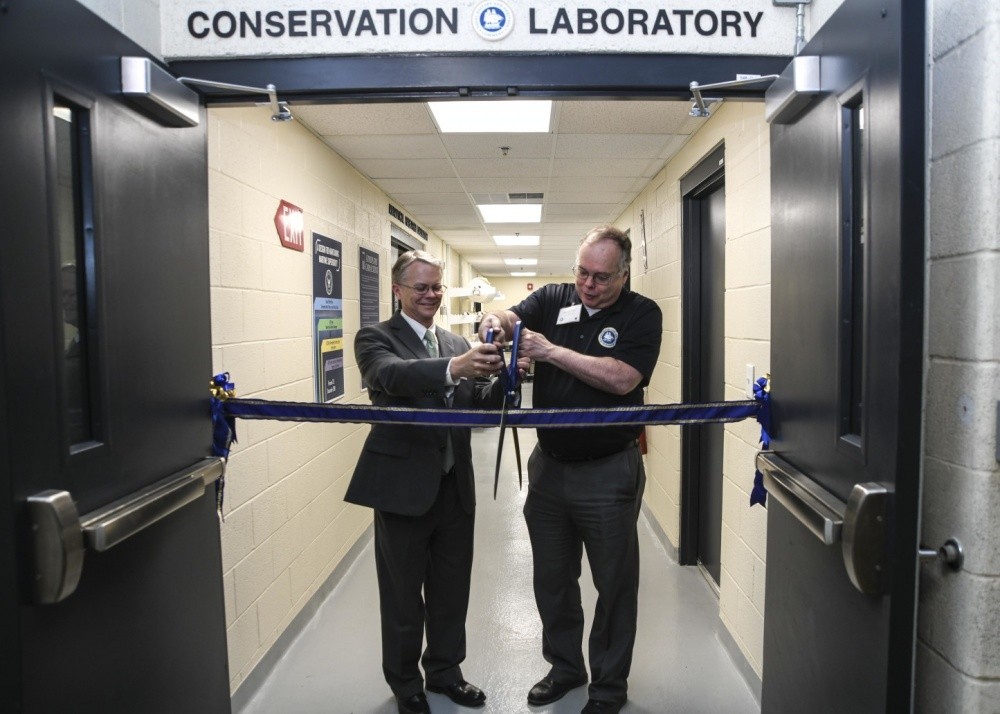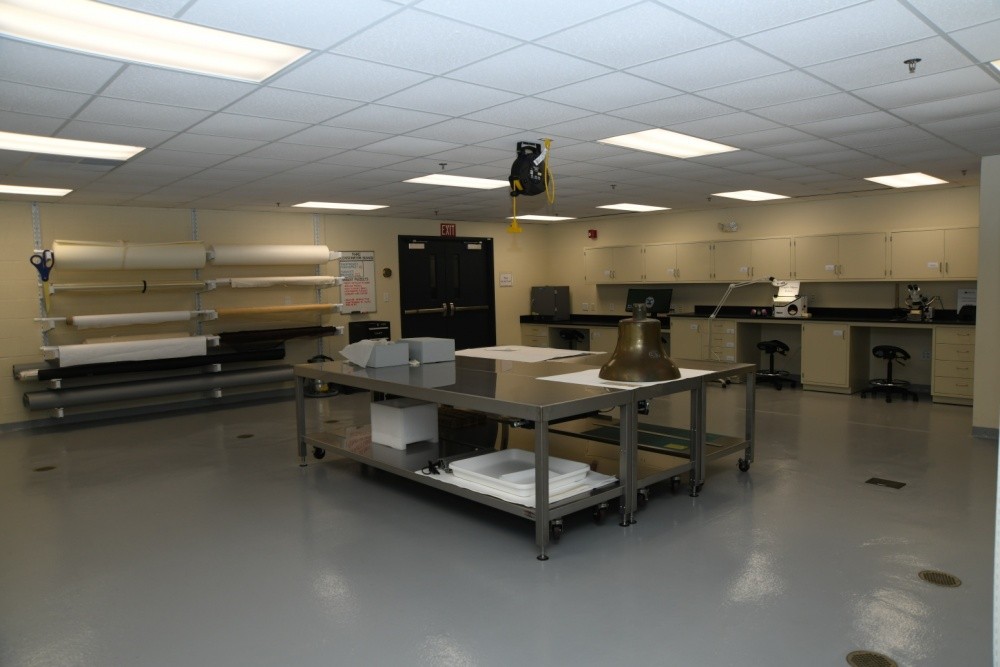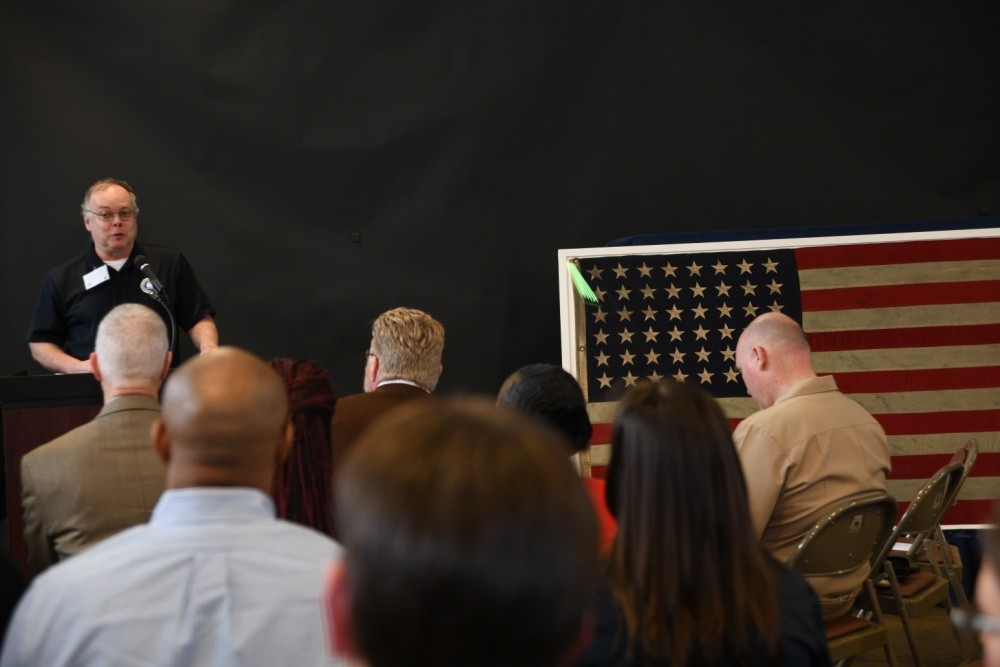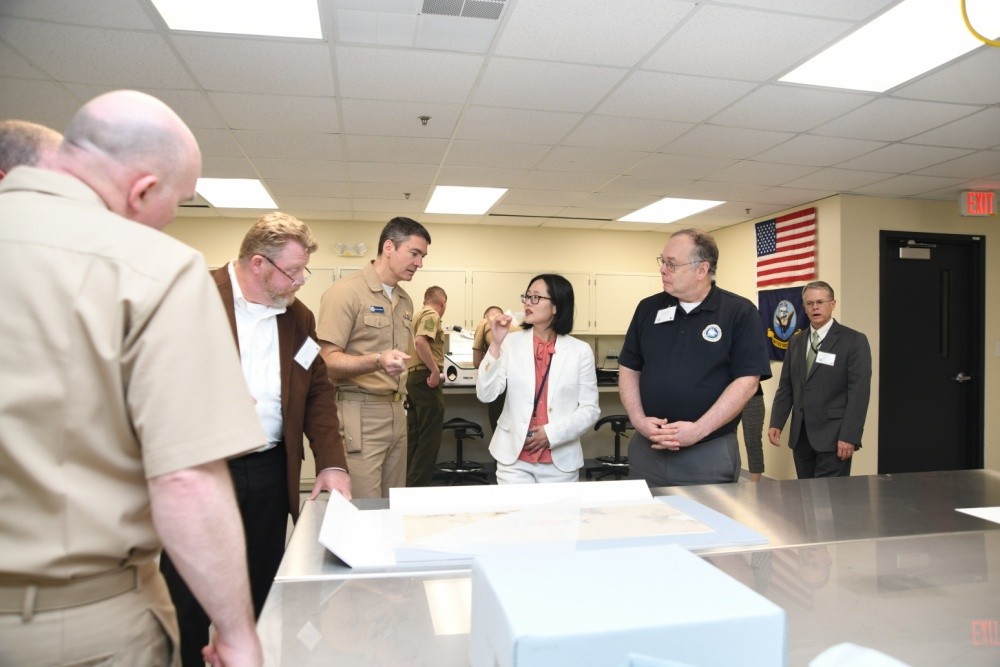
By Mass Communications Specialist 2nd Class (SW/AW) Mutis A. Capizzi, Naval History and Heritage Command, Communication and Outreach Division
RICHMOND, Va. – The staff of the Naval History and Heritage Command’s (NHHC) Conservation Branch officially opened their new, state-of-the-art artifact conservation lab during a ribbon cutting ceremony May 1.
Located at NHHC’s Collection Management Facility in Richmond, Va., the conservation lab now gives the Navy the ability to perform complex, scientific conservation work on many of its more than 300,000 historic artifacts, a service that previously had to be contracted out to civilian conservators.
According to David Krop, who heads the Conservation Branch, the lab makes it possible for his team to more effectively preserve and protect the Navy’s history.
“The conservation lab opening marks a notable shift in our capability as a command, and speaks volumes about the Navy’s dedication to proactively preserve the history and heritage of American Sailors,” said Krop. “Being able to perform critical preservation work on our artifacts in-house means we’re better equipped to care for the Navy’s collection.”

The Conservation Branch is tasked with analyzing and conserving, as well as ensuring the proper care and preservation, of the Navy’s historical artifacts such as ships’ bells, equipment, arms, ordnance, uniforms, personal equipment, and plaques. These activities include condition assessments, scientific analysis, stabilization and treatment, artifact re-housing, developing appropriate storage solutions, and providing exhibit guidance and support to those who store or display the artifacts. The ultimate goal is to increase the physical stability of the Navy’s artifact collection and provide the Navy and general public greater access to the collection.
NHHC Director Rear Adm. Sam Cox, USN (Ret.) believes the capability the lab offers is an important element in the vital mission of preserving and sharing the Navy’s history and heritage.
“What the conservators do here is important and it does matter,” said Cox. “I am glad you all are here at the conservation lab opening today to see the Navy taking its history seriously. The work that is done here makes a huge difference in how the Naval History and Heritage Command preserves and protects our nation’s and our Navy’s history.”

The team of dedicated professionals who will use the lab to physically save the Navy’s cultural property from the ravages of time are excited about what it will mean to their ability to meet their mission.
“It has been an honor to help preserve the legacies of all who have served in the Navy,” said Karl Knauer, a conservator at CMD. “Now, with these new enhancements to our facility and capabilities we are eager to provide the highest standards and quality conservation treatments for these artifacts. “
Work formally began on the lab in October 2018, but the facility’s development started long before. In 2014 NHHC opened up its Collection Management Facility, which allowed the command to consolidate the Navy’s historic artifact collection from several different locations across the country. Having a space to safely store artifacts was just one part of the solution.
The need to perform preservation work on the items in the collection resulted in the establishment of the Conservation Branch in September 2015. As the staff grew they conducted preservation work on an ad hoc basis using the tools available at that time.
Conservation Branch personnel can now deploy their professional expertise in an appropriate laboratory setting. The lab is equipped with steel cabinetry and casework, chemical-resistant counters, mobile hydraulic workbenches, a water filtration system, 8-foot ducted fume hood, direct access to a loading dock, and climate-controlled artifact storage. In addition, conservators also procured specialized tools, equipment, and consumables necessary to support treatment of textiles, metals, and other materials. All of the increased capabilities will allow NHHC to widen the knowledge base of how materials change and deteriorate, and that knowledge can be shared across the naval history enterprise as well as with stakeholders and the museum community in general.
Today, the lab opened for business with more than 1,400 square feet, 500 of which is for research and development. The R&D space provides conservators with the ability to perform Smithsonian-level forensic science and analytical interpretation using state-of-the-art instrumentation like a polarized light microscope, x-ray fluorescence unit, and multi-spectral imaging. Conservation staff also maintain a larger industrial treatment area within the warehouse complex for the treatment of larger artifacts, like a 23-foot wooden sampan captured in 1968 by U.S. Navy forces during the Vietnam War. The sampan will be a focal point of HRNM’s upcoming Vietnam exhibit.

“The Navy’s historic artifact collection depicts its 240 plus year-history, which, as you can imagine has some larger-than-average artifacts,” said Krop. “It’s our job to provide the treatment necessary to ensure these pieces of America’s history are preserved and available to publically share the Navy’s story in perpetuity.”
The first items undergoing treatment in the new lab are two dozen unique artifacts for a Vietnam War exhibit opening this fall at Hampton Roads Naval Museum (HRNM), as well as a Barbary War sword, medals, and two bells slated for loan to the Pentagon.
The Naval History and Heritage Command, located at the Washington Navy Yard, is responsible for the preservation, analysis, and dissemination of U.S. naval history and heritage. It provides the knowledge foundation for the Navy by maintaining historically relevant resources and products that reflect the Navy's unique and enduring contributions through our nation's history, and supports the fleet by assisting with and delivering professional research, analysis, and interpretive services. NHHC is composed of many activities including the Navy Department Library, the Navy Operational Archives, the Navy art and artifact collections, underwater archeology, Navy histories, nine museums, USS Constitution repair facility, and the historic ship Nautilus.
For more news from Naval History and Heritage Command, visit www.history.navy.mil.
NOTE TO MEDIA: For additional information about naval history, please contact the Naval History and Heritage Command’s Communication and Outreach division at 202-433-7880 or via email at NHHCPublicAffairs@navy.mil


